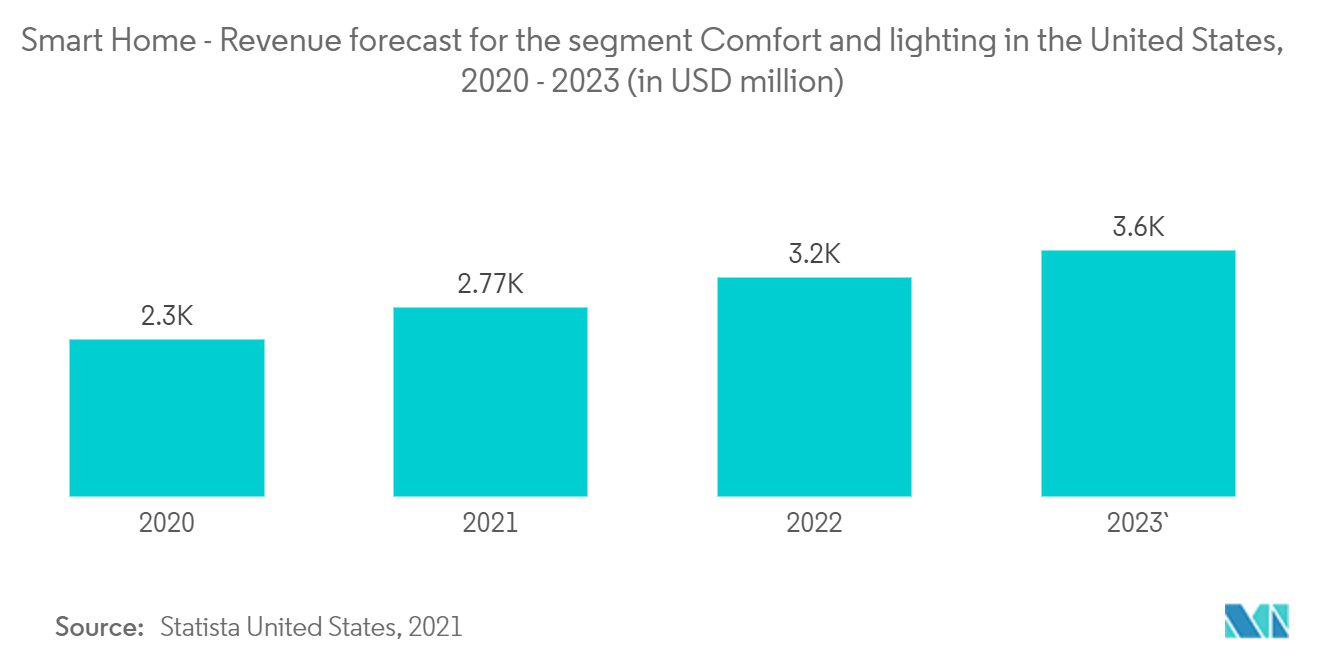Market Trends of North America Commercial LED Lighting Industry
This section covers the major market trends shaping the North America Commercial LED Lighting Market according to our research experts:
Smart Lighting is Expected to be the Future of Commercial LED Lighting
- Every commercial environment requires work-centric uniform illumination, owing to various applications. LEDs' high efficiency and directional nature make them ideal for several applications such as in Retail, Offices, and Hospitality, among others. In addition, LEDs offer up to 90% greater efficiency than the conventional HID systems used for such applications.
- The United States is a developed and commercialized society, with Americans using significant energy across businesses and industries. According to American Geo Sciences (AGI), the industrial sector consumes 32% of all power, including electricity, facilities, and equipment used for manufacturing, mining, agriculture, and construction. With the region's high energy consumption, the government should invest significantly in greener, smarter, and more efficient solutions.
- The advent of the Internet of Things (IoT) and the subsequent introduction of new business models, such as Lighting-as-a-Service (LaaS), has eliminated the need for high upfront payments, allowing the market to shift to an OPEX model. The leasing model has enabled large-scale installations of LED lights and their adoption in the commercial segment.
- Owing to the rising need to save energy, leading players in the market, such as Verizon, have introduced innovative and cost-effective measures for streetlights. The Verizon Intelligent Lighting platform converts LED fixtures into sensor-equipped smart devices that capture and transmit data in near real-time such that one can get full control over all lights, insights into the state of lighting infrastructure, and access to an array of lighting applications and services.
- Further, in July 2021, Smart labs, a pioneer in smart lighting and electrical control, announced the launch of Nokia Smart Lighting, a suite of IoT-powered lighting and electrical control products. The first-ever Nokia Smart Lighting products are designed to make smart lighting straightforward to buy, easy to install, and intuitive for office spaces and hospitality solutions.

United States to Hold Major Market Share
- According to the US Energy Information Administration, LED lights have become the second most common bulb type in commercial buildings. Laws such as the Energy Independent and Safety Act of 2007 have had a significant impact on the growing use of more efficient lighting options by establishing minimum efficiency requirements for producing new light bulbs.
- According to the long-term energy forecast for Annual Energy Outlook 2021 (AEO2021), the US Energy Information Administration expects LED lighting to continue to grow, meeting up to 95% of the commercial lighting demand by 2050.
- Moreover, the controllability of LED lights is also driving their demand in the commercial sector. Capabilities, such as dimmability, daylighting, occupancy sensors, and timers, are enticing vendors to implement the solutions in their facilities.
- Companies are innovating new LED solutions to sustain themselves in the market. For instance, in July 2021, Lumileds Holding, with its operational headquarters in the United States, introduced its new LUXEON 2835 Commercial LEDs. These LEDs are engineered and designed to support the increasing demand for a high volume, high-efficacy mid-power LED to serve commercial indoor lighting applications. Typical commercial indoor applications include troffers, panels, and high-bay, among other formats.
- Additionally, the government is also regulating the lighting systems used in commercial spaces, limiting energy consumption. For example, the Federal Energy Management Program (FEMP) provides guidance for the acquisition of commercial light-emitting diode (LED) luminaires in the United States. Such trends are anticipated to drive the growth of the market studied during the forecast period.


